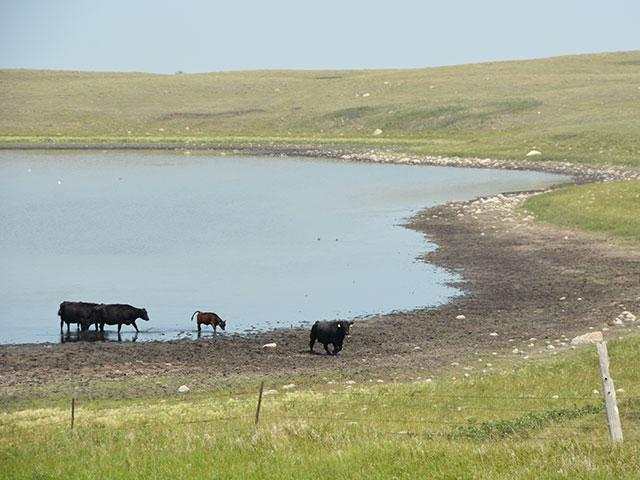Cow-Calf Producers Face Drought Issues
Different Practices Can Help Cow-Calf Producers Handle Drought
OMAHA (DTN) -- For cow-calf operations, drought can affect forage production yield. It can also severely affect animal performance and health.
However, there are some ways to stretch forage during times of drought. Cattle owners can reduce stocking rates, alter grazing practices and wean calves early.
DROUGHT LIMITS FORAGE
During a recent Kansas State University (KSU) Beef Extension question-and-answer webinar titled "Dealing with Drought," Extension specialists received many questions from Kansas livestock producers.
Forage production and how much production could be lost during drought was the focus of several questions.
Keith Harmoney, KSU Extension range scientist at the KSU Ag Research Center in Hays, said how much moisture falls in May and June will dictate how much grass is available for grazing. If the state can get rains during these months, the outlook for forage production is promising.
If moisture is not seen, then the outlook is much cloudier for forage production. Some producers might consider lowering stocking rates by the end of May if less production is apparent, he said.
"There is a good relationship with how much forage we see during the growing season and moisture during these months," Harmoney said.
WEST AREAS DRY
Walt Fick, KSU Extension range management specialist, said the projection is parts of central and western Kansas could continue see drought conditions through this summer. Some areas of northwest and southwest Kansas are in extreme (D3) and exceptional (D4) drought (https://droughtmonitor.unl.edu/…).
Producers in these regions should assume that forage production could be reduced around 30%. Nearly 2/3 of the state is drier than normal, he said.
He recommended producers think about what drought practices they can adopt to ensure they have enough forage and set a target date of June 15 to start applying some of these, he said.
Fick said producers should work to even out grazing distribution to allow better grass usage, he said.
P[L1] D[0x0] M[300x250] OOP[F] ADUNIT[] T[]
DETERMINE GRAZING DAYS LEFT, CONSIDER CULLING
"I would say determining how many days of grazing is left is pretty important," Fick said. "If you only have 50% production, this limits the days of grazing left."
KSU Extension has different tools available to help producers determine how much to scale back grazing during drought.
Fick said producers should also look at their cull practices and get rid of lower-producing cows to save forage for other, more productive cows.
Harmoney said splitting large pastures into smaller ones also helps with distribution. This will force cattle to utilize different grasses they might ignore if they were in a larger pasture.
A major component of splitting large pastures into smaller ones is what water sources would be available. Producers might be limited as to how much this can be accomplished if there is no water available, he said.
The issue of grazing/baling CRP acres was touched upon in the webinar.
Harmoney said generally if CRP acres are opened, the quality of the forage is lower, as it is usually in July the acres are released. Keep in mind that CRP acres can produce good tonnage but usually the quality is not very good, he said.
EARLY WEANING OPTION
A common practice for cow-calf operations during drought is to wean calves early to save grazing resources for the cow. The calf is then moved to the feedlot while the cow will graze without the calf, needing less nutrients.
While an effective tool, the practice does require a higher level of management.
KSU Extension Beef Cattle Specialist Justin Waggoner said many producers ask: How early can calves be weaned? Calves' rumen is fully developed by the time they are 40 to 42 days old, he said.
Research shows that early weaning can occur anytime from 100 to 120 days of age. The best time to do early weaning is at 120 days, he said.
Calf nutrition is important in early weaning. Calves should be fed a nutrient-dense diet to meet their nutritional needs, he said.
Waggoner said intake should be about 1% of body weight and calves should be fed about 3 to 5 pounds per day. Feed conversion should be around 3.5-4:1.
"It isn't easy, but you can get an acceptable performance level," Waggoner said.
Also, make sure these younger, smaller calves can reach water in tanks and feed in feed bunks, he said.
COWS FACE STRESS
Both cows and calves face a wide array of stress during drought, according to KSU Extension Beef Veterinarian AJ Tarpoff. Environmental stressors affect cattle health during dry periods, he said.
Grouping cattle together might lead to higher rates of respiratory diseases. Foot root could be an issue during drought, as the dry air leads to chapping and cracking at the hoof.
With it being dry outside, there will probably be higher levels of dust in the air, Tarpoff said. This can lead to more cases of pinkeye in both cattle and calves.
"Cattle eat things they shouldn't be eating during drought," Tarpoff said. "They eat plants they generally don't and there could be some poisoning issues."
Cattle producers also need to pay attention to water sources since drought can lead to water quality issues, such as higher levels of nitrates, iron and sulfur.
Water sources can be tested to assure the water is safe for livestock to consume.
A complete list of drought resources can be found at https://www.asi.k-state.edu/….
Russ Quinn can be reached at Russ.Quinn@dtn.com
Follow him on Twitter @RussQuinnDTN
(ES/CZ )
(c) Copyright 2022 DTN, LLC. All rights reserved.




